Whenever a new president enters the White House, big changes follow. From cabinet secretaries to ambassadors, personnel changes tend to dominate the headlines when administrations turn over. However, some of the most interesting and historically relevant changes that occur have little to do with policy and more to do with interior design. The decoration of the Oval Office can represent the personality of a president, their political role models, and the ambitions of their time in office — as well as their favorite color schemes.
The modern Oval Office was established in 1909 when President Taft invited submissions from architects to design the permanent office of the executive. A Washington architect named Nathan C. Wyeth won the competition and gave the office the distinctive oval shape it is known for today.
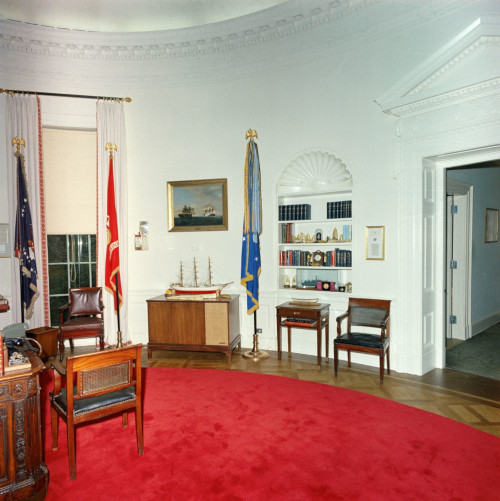
The most common changes to the office from administration to administration involve the rug and drapes that provide the iconic framing of the Resolute Desk. Surprisingly, the drape-rug color scheme was an unpatriotic blue-green from the Taft administration all the way to the 1960s. It was only until the 1961 renovation of the White House, spearheaded by Jackie Kennedy, that the Oval Office’s color scheme matched that of the American flag. The Kennedys chose to break with tradition and installed an iconic bright red rug with white curtains. Since the Kennedy renovation, almost every president has brought in their own custom rug and drape combination to stamp their own personal style on the office. President Biden has opted for a dark blue rug with the Presidential Seal woven into the middle — the same rug used during the Clinton Administration.
Franklin Delano Roosevelt was the first president to move the Resolute Desk from the middle of the room to the rear, allowing more space for aides, guests, and in some cases, children to inhabit the office more comfortably. Presidents Taft, Wilson, Harding, Coolidge, and Hoover all
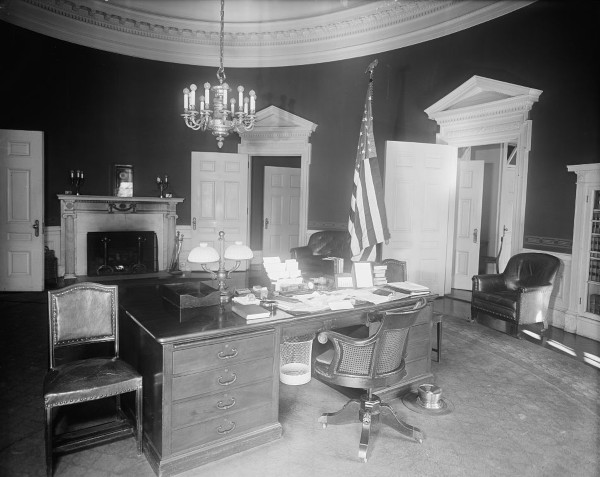
had the desk positioned in the center of room, which allowed crowds to more easily congregate behind the president. The newfound space generated by FDR’s designers opened up room for couches and chairs, which have provided some the most iconic photos of the office. For President Biden’s seating arrangements, decorators dug into the White House furniture archive to use couches first featured in President George W. Bush’s Oval.
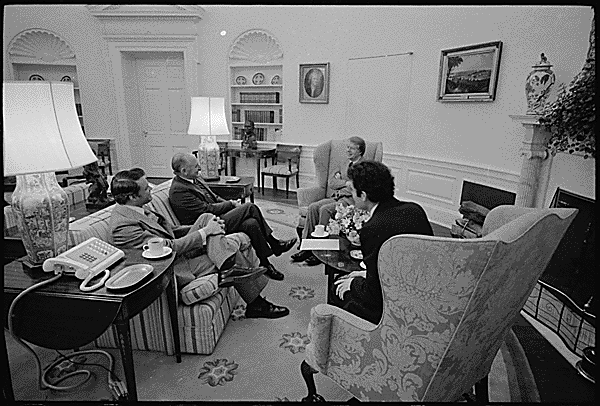
Portraits have lined the walls of the Oval Office since its conception. They offer an inside look into the heroes and ambitions of the residents of 1600 Pennsylvania Avenue. President Biden has chosen to place almost all of his portraits directly across from the Resolute Desk, offering him a clear view of the group of men. A large painting of FDR gazes down upon the room as portraits of Thomas Jefferson, Abraham Lincoln, Alexander Hamilton, and George Washington flank either side. Biden’s office told the Washington Post that the pairing of fierce rivals Alexander Hamilton and Thomas Jefferson was intentional. The pair should be seen as “hallmarks of how differences of opinion, expressed within the guardrails of the Republic, are essential to democracy,” he said.
Over the years, additions to the Oval Office have included American landscape paintings, busts, and the occasional modern sculpture. However, President Biden has selected a unique addition to his office this year – one that the president had to ask permission to use: Lunar Sample 76015,143, a Moon rock collected in 1971 by the last humans to walk on the Moon as part of the Apollo 17 mission. The rock was lent to the President by NASA and will be the oldest artifact ever to find its home in the Oval Office, coming in at 3.9 billion years old. The Moon rock can be found close to the newly added portrait of Benjamin Franklin, acting as a reminder of American ambition and past accomplishments.
Some objects have managed to survive changes of administrations, styles, and preferences. The Resolute Desk is an Oval Office tradition that has never been broken. The desk is made from the wood of the sunken HMS Resolute and given to President Rutherford B. Hayes by Queen Victoria in 1880. Before the 1960s the desk lived in the President’s Study and the White House Broadcast Room. It was first featured in the Kennedy Oval Office and has been used by every president since then.
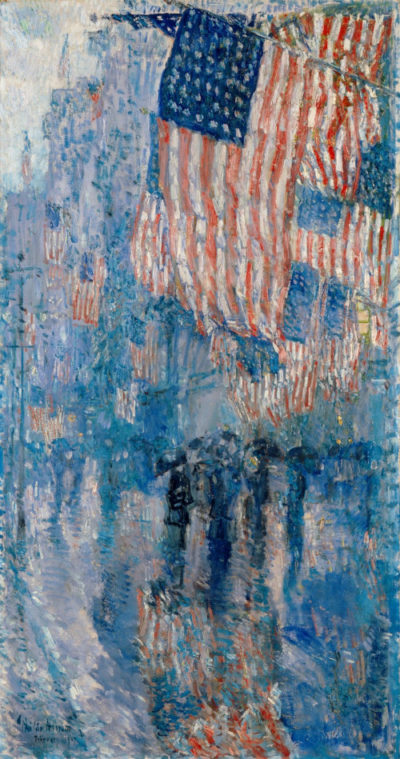
Presidents from differing parties and states have all taken a liking to the painting Avenue in the Rain by impressionist Childe Hassam, making it a mainstay in recent Oval Offices. The painting depicts a rainy Fifth Avenue in New York City shadowed by several American flags. The piece is part of series of flag depictions by Hassam that were inspired by the American struggle of World War I. The artwork has been in the White House collection since 1963 and has hung in the president’s bedroom, dining room, and most recently, the Oval Office for the terms of Presidents Clinton, Obama, Trump, and Biden. A very similar flag painting by Hassam entitled The Fourth of July was featured on the cover of The Saturday Evening Post in the July/August 2018 issue.
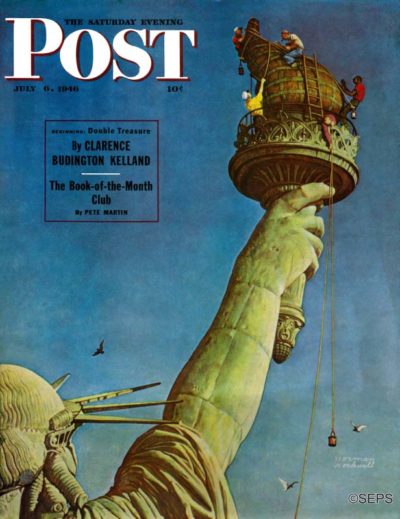
The Post has a deep connection to the Oval Office that has been well documented over the years. President George W. Bush brought the painting A Charge to Keep by W.H.D. Koerner with him from the Texas governor’s mansion to the White House; it was originally featured in a 1916 issue of the Post. President Clinton brought in a Norman Rockwell painting, donated to the White House by director Steven Spielberg, that graced the cover of the Post in the July 1946 issue. The iconic painting is entitled Working on the Statue of Liberty. A number of other Rockwell paintings can be found in the White House collection and around the West Wing.
Through all of the renovations, remodels, and redesigns of the Oval Office, an air of patriotism has remained. From historical paintings to historical desks, each president has been able to make their office uniquely theirs and uniquely American.
Featured image: President Taft in the Oval Office (Library of Congress)
Become a Saturday Evening Post member and enjoy unlimited access. Subscribe now
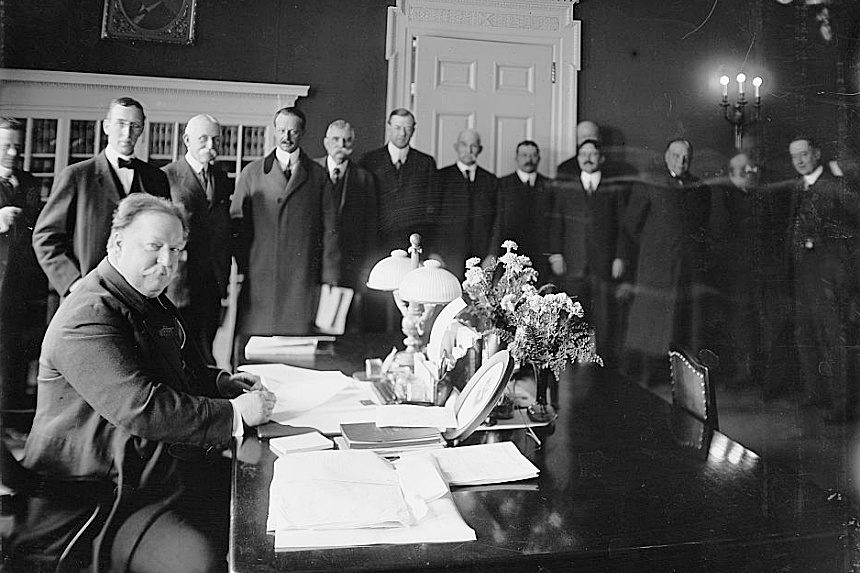

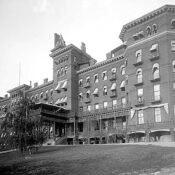

Comments
The red rug and white drapes were installed while JFK was in Dallas in 1963. He never used that decor, a d the rug was removed by LBJ.
Lyndon Johnson, Nixon, Ford and HW Bush did not use the Resolute desk in the Oval Office
Very interesting article about the interior design of the Oval Office. What was missing, though was any account of the in and out bust of Winston Churchill. Obama removed it, Trump replaced it, Biden removed it again. All very strange considering that Winston Churchill was such a good friend of FDR, the iconic Democratic Party standard bearer.